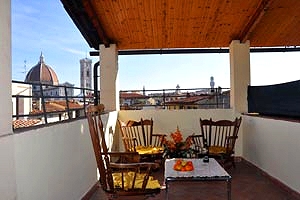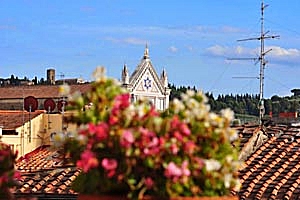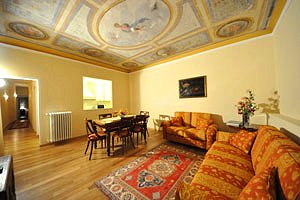Church of San Lorenzo : The Works of Art
....
Church of San Lorenzo
The most important work of art is undoubtedly the architecture. Just how closely the actual building adhered to Brunelleschi`s plans, it is impossible to say; we can however recognise at San Lorenzo all the elements of renaissance archi tecture, that are here employed for the first time in a large-scale religious building. We enter an architectural space con ceived in the modern manner, with total legibility of construc tion: our eye manages to take in the entire development of the building and to identify with precision the fundamental ele ments. The vertical and horizontal load-bearing structures, the columns, pilasters and arches, are distinguished both in colour and material from the complementary structures, walls and windows. The legibility of the architectural space - based on the alternation of grey and white -, the mathematical and geo metrical proportions between the various potions of the build ing, and the diffused lighting which creates no areas of deep shadow, confer on the architectural space of San Lorenzo an exceptional harmonious beauty.

Cappella dei Principi
San Lorenzo contains masterpieces by Donatello (1386-1466), including the Sarcophagus of the Martelli family, and the two bronze pulpits.
The sarcophagus, in the form of a wickerwork basket, was com missioned by Roberto Martelli around 1464, for the family chapel located between the left transept and the nave. In Donatello`s hands this simple domestic object, a symbol of love of family, assumes the characteristics of a work of art through the masterly carving of the marble, emphasising the roundness of the form and the sinuous patterns of the weaving. Also dating from the 1460s are the reliefs commissioned by Cosimo il Vecchio for the presbytery area, which were left unfinished by Donatello and his assistants. On the occasion of the visit of Pope Leo X Medici the reliefs were provisionally assembled; in the course of the 17th century they were set up on the two pulpits, with the addition of extra panels carved out of wood and treated to imitate bronze. The arches were mounted on columns and were set up on either side of the nave, near the transept, where they are still to be seen. The sculptures forming the left-hand pulpit represent scenes from the Passion and Death of Christ. The right-hand pulpit shows in a single scene, divided by symbolic doorways, the Descent into Hell, the Resurrection, and the Ascension. The cycle is completed by individual panels showing the Maries at the Tomb, Pentecost and the Martyrdom of St Laurence. These panels display the enormous expressive range of bronze bas-relief: the surfaces are animated with the interplay of light, conveying both dramatic excitement and sorrowful contem plation following the Saviour`s death. In the panel of the Res urrection, we realise with amazement that the artist`s concen tration on figures and actions does not diminish the aesthetic

Cappella Medicea
impact of the Christ who emerges from His tomb with narrowed eyes, the
standard of victory clasped in Hishands, the cerements still clinging
to His limbs. Among the numerous paintings that adorn the altars and chapels of the church, tempering with their bright colours the austere whites
and greys of the architecture, we notice unusual iconographical features in the Annunciation in the Martelli Chapel, painted by Filippo Lippi around 1420. Our eye is caught by the elegant ampoule of transparent glass standing in the foreground, between the Virgin and the Angel. The light passing through this glass vase is intended to recall the action of the Holy Spirit, who makes
the Virgin conceive. There are three more angels, with white, green and red wings, who symbolise the three theological virtues of Faith, Hope and Charity, as they are present in the mind of Mary while she receives the message from God. The Betrothal of the Virgin in the second chapel in the right aisle is a masterpiece of Tuscan mannerism. The panel, signed by Rosso Fiorentino and dated 1523, shows Mary and Joseph as two youthful participants at a happy gathering attended by numerous guests: the non-traditional use of colour and composition here achieves a remarkable expressive felicity. The most recent painting in San Lorenzo is the one of St Joseph and the Christ Child, painted in 1964 by Pietro Annigoni. This entirely traditional picture is utterly lacking in rhetoric, concen trated as it is on the paternal affection of Joseph, who is evi dently aware of the greatness of his Son. Jesus` destiny is sug gested by the wooden lathes in the foreground, which form a Cross by means of chromatic effects obtained with gold.
This small square-planned building, surmounted by a hemi spherical dome, is a synthetic and effective expression of the early-renaissance aesthetic. It has a scarsella or miniature apse, also square-planned and vaulted. It was designed by Filippo Brunelleschi and finished in 1428.
The sculptural decoration, which harmonises closely with the architecture, forms a small anthology of sculptural materials and techniques. It was for the most part executed by Donatel lo between 1428 and 1432. The string-course cornice has a frieze with alternating cherubim and seraphim of polychrome terracotta in red, blue and gold. The roundels in the spandrels of the cupola have Scenes from the Life of St John the Evan gelist, done in very low relief, in stucco painted in pale tones of cream, brick-red and blue. In 1435 Donatello completed the decoration above the string-course cornice with four roundels placed in the lunettes, showing the Four Evangelists, also in polychrome stucco, but in more traditional style with brighter colours and higher relief.
Later, between 1440 and 1443, the artist executed the two sets of bronze doors surmounted by aedicules of polychrome stucco with St Laurence and St Stephen (left) and St Cosmas and St Damian (right). In harmony with these aedicules, the panels on the doors show pairs of Saints and Martyrs, and pairs of Apostles and Fathers of the Church. The architecture of the Old Sacristy is constituted by forms and numbers which in Judaeo-Christian tradition connote perfec tion. This rigorous scheme is based on the cube and the sphere, the square and the circle, on the numbers four and three and their mathematical combinations. Light is diffused from the cupola by twelve circular windows at the base of the hemisphere, and by the central lantern. The scarsella, the funerary monuments to the Medici family and the furnishings are conceived as complementing the archi tecture and as tempering the formal austerity of the Old Sacristy.
.. from Basilica of San Lorenzo ( Opera Laurenziana - Associazione Ars et Fides - Florence )
Our most requested apartments in the Florence historical centre:
 Holiday apartments in pretty villa on the southern outskirts of Florence, in the vicinity of Piazzale Michelangelo. Accommodation for groups of 4/6/8/10/12 people. Air conditioning, Internet connection. Just a few minutes from Florence historical centre.
More details
Holiday apartments in pretty villa on the southern outskirts of Florence, in the vicinity of Piazzale Michelangelo. Accommodation for groups of 4/6/8/10/12 people. Air conditioning, Internet connection. Just a few minutes from Florence historical centre.
More details
 Beautiful apartment sleeping 6+2 in Florence historic centre, at a stone`s throw from Santa Maria Novella railway station. Air conditioning, Internet connection and panoramic balcony with view over the Duomo and the Medici Chapels.
More details
Beautiful apartment sleeping 6+2 in Florence historic centre, at a stone`s throw from Santa Maria Novella railway station. Air conditioning, Internet connection and panoramic balcony with view over the Duomo and the Medici Chapels.
More details
 Apartment sleeping 2+1 in the heart of Florence historic centre, in the district of Santa Croce. Panoramic balcony with view over the basilica of Santa Croce, air conditioning, Internet connection, close to the most important Florentine monuments.
More details
Apartment sleeping 2+1 in the heart of Florence historic centre, in the district of Santa Croce. Panoramic balcony with view over the basilica of Santa Croce, air conditioning, Internet connection, close to the most important Florentine monuments.
More details
 Apartment in the historical centre of Florence a few steps away from the Accademia Gallery. Nearby Piazza Duomo, Piazza Signoria, the Uffizi Gallery . 5+2 beds, Internet Connection and air conditioning.
More details
Apartment in the historical centre of Florence a few steps away from the Accademia Gallery. Nearby Piazza Duomo, Piazza Signoria, the Uffizi Gallery . 5+2 beds, Internet Connection and air conditioning.
More details


 Holiday apartments in pretty villa on the southern outskirts of Florence, in the vicinity of Piazzale Michelangelo. Accommodation for groups of 4/6/8/10/12 people. Air conditioning, Internet connection. Just a few minutes from Florence historical centre.
More details
Holiday apartments in pretty villa on the southern outskirts of Florence, in the vicinity of Piazzale Michelangelo. Accommodation for groups of 4/6/8/10/12 people. Air conditioning, Internet connection. Just a few minutes from Florence historical centre.
More details
 Beautiful apartment sleeping 6+2 in Florence historic centre, at a stone`s throw from Santa Maria Novella railway station. Air conditioning, Internet connection and panoramic balcony with view over the Duomo and the Medici Chapels.
More details
Beautiful apartment sleeping 6+2 in Florence historic centre, at a stone`s throw from Santa Maria Novella railway station. Air conditioning, Internet connection and panoramic balcony with view over the Duomo and the Medici Chapels.
More details
 Apartment sleeping 2+1 in the heart of Florence historic centre, in the district of Santa Croce. Panoramic balcony with view over the basilica of Santa Croce, air conditioning, Internet connection, close to the most important Florentine monuments.
More details
Apartment sleeping 2+1 in the heart of Florence historic centre, in the district of Santa Croce. Panoramic balcony with view over the basilica of Santa Croce, air conditioning, Internet connection, close to the most important Florentine monuments.
More details
 Apartment in the historical centre of Florence a few steps away from the Accademia Gallery. Nearby Piazza Duomo, Piazza Signoria, the Uffizi Gallery . 5+2 beds, Internet Connection and air conditioning.
More details
Apartment in the historical centre of Florence a few steps away from the Accademia Gallery. Nearby Piazza Duomo, Piazza Signoria, the Uffizi Gallery . 5+2 beds, Internet Connection and air conditioning.
More details







